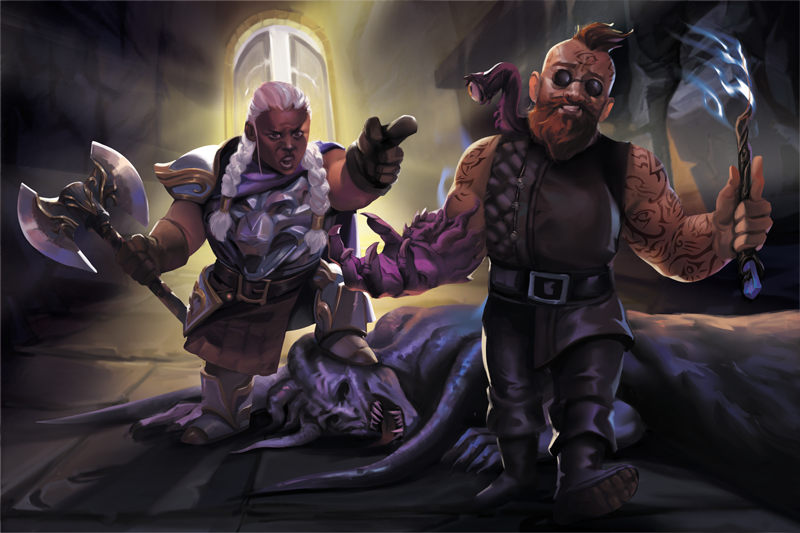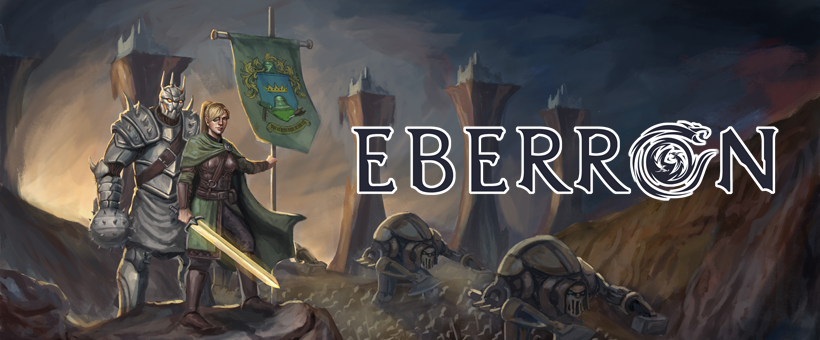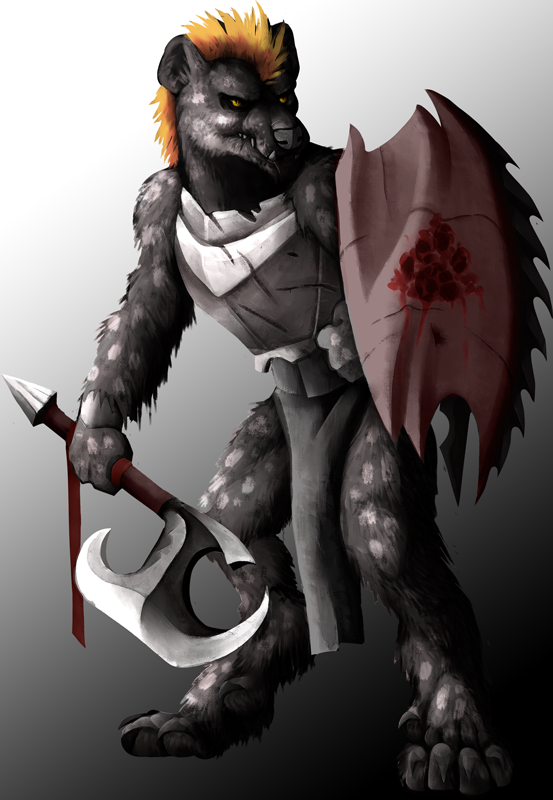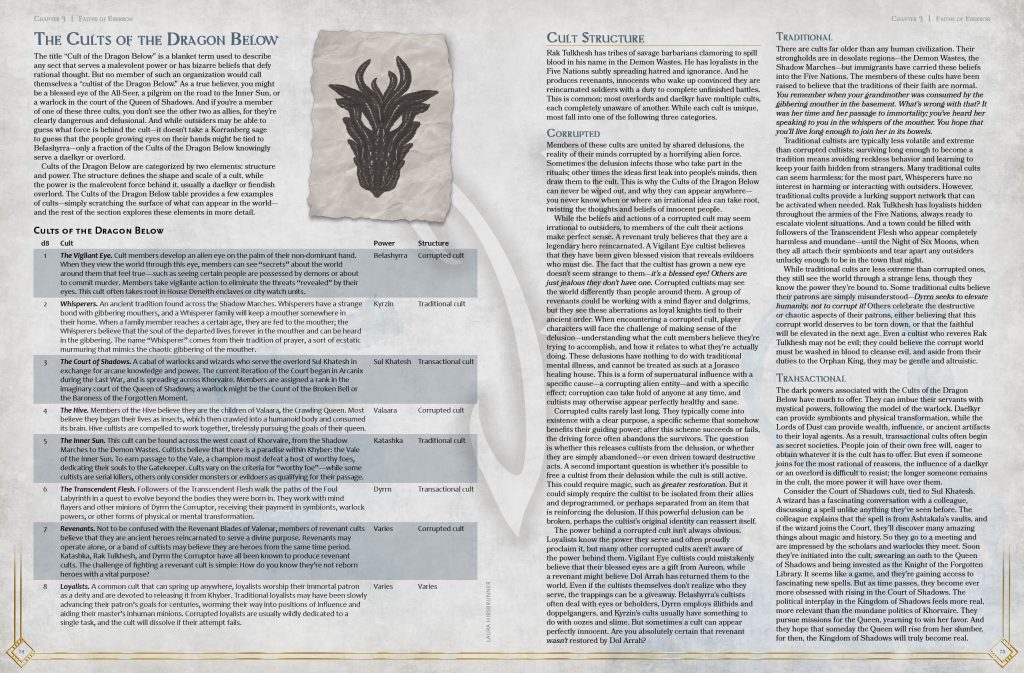
In March’s poll, my Patreon supporters selected Mror dwarves as the subject for this article. Exploring Eberron covers the Mror in more depth, delving into the history of the Holds, the cultures of the ruling clans, and further information about the ongoing conflict in Khyber—along with the symbiont that have been claimed as spoils of war. So there’s lots more (Mror!) to look forward to… but today, let’s look at what it means to be Mror.
Dwarves aren’t human. In creating a Mror character it can help to reflect on the ways in which dwarves differ from humanity. Clan plays a significant role in Mror culture, but there’s a few common things that can be born in mind for any Mror character.
DARKVISION
While the dwarves of the Realm Below may have spent their entire lives below the surface, the Mror dwarves were born on the surface of the Ironroot Mountains. Mror dwarves appreciate sunlight and color, and their buildings typically have windows. However, dwarves don’t need light. While in total darkness a dwarf suffers disadvantage on sight-based Perception checks. This is inconvenient, but not unbearable. Areas where people need to do skilled work will have at least dim light. But many mine tunnels and stretches of the Realm Below have no light sources.
A more general impact is that the circadian rhythms of dwarves are more flexible than those of humans. While it’s important to maintain a regular schedule, day and night have little meaning for the Mror. Mror communities are active at all hours, and major Mror businesses are continuously open. “Nightlife” isn’t a concept in Mror society, and entertainment can likewise be found at all hours; traveling Mror are often frustrated by the limited opportunities in human communities.
THE WAR BELOW
Characters from the Five Nations are shaped by the Last War. Mror are shaped by Dol Udar, the War Below. Currently this conflict is simmering, with a stalemate along the deep siege lines, but there has been no victory and the threat remains. When the war was at its height, all Mror lived in daily fear of aberrant attacks and the full resources of the holds were directed to the war effort. The Mror Holds are smaller than the Five Nations, and the impact of the conflict was intense. All civilians engaged in combat drills in preparation for dolgrim assault, and everyone was expected to contribute to the war effort—repairing or producing arms and armor, maintaining fortifications, or fighting.
For the Mror, this is the source of the Weapon Training and Tool Proficiency racial features. In creating a Mror character or NPC, consider how the war affected you and how this is reflected by your class and proficiencies. A few questions to consider…
- Did you fight on the front lines, battling aberrations in the depths? If so, what’s the most terrifying thing you saw in the conflict? Are you scarred by your experiences, or does nothing scare you anymore?
- If you didn’t fight in the Realm Below, did you serve on any civilian support brigades? Did you spend your childhood sharpening axes and repairing armor (proficiency in smith’s tools) or working on fortifications (mason’s tools)? Were you kept out of the conflict by family connections, or did you refuse to serve?
- Who or what did you lose to the conflict? Did you have a stake in a colony or mine that had to be abandoned? Do you have a sibling or lover lost in the depths—and if so, do you know that they’re dead, or could they be prisoners of Dyrrn?
- Do you dream of delving deeper into the depths, or would you rather see the Realm Below sealed away forever?
If you use your racial Tool Proficiency for brewer’s tools, you may have been involved in creating supplies for soldiers. However, this is also a common choice for Mror who venture beyond the holds. As mentioned later, the alcohol of the Five Nations is extremely weak by Mror standards, and some consider the ability to brew personal supplies to be a basic survival tool when traveling in foreign lands.
FAMILY FIRST
The Mror Holds are a feudal society. There are twelve active holds. Each is governed by a ruling clan, which gives its name to the hold; Droranathhold is ruled by Clan Droranath. Each hold is then broken up into smaller territories known as spires, each ruled by a clan; there are ancient ties of kinship and marriage between clans and the ruling clan. Within a spire, families maintain tenant relationships with the local clan. Land is held by a clan or family, and most businesses are family businesses. Families are long established, and the creation of an entirely new family is a rare event.
The Mror engage with their history through stories, and clans and families are the characters in those stories. Typically, a Mror tale refers to heroes and villains solely by their family names. So in Mroranon and the Troll King, it doesn’t matter exactly when the story took place or WHICH specific Mroranon it was; it’s a story about Mroranon, and any Mroranon dwarf should strive to live up to that example. Where the Tairnadal elves seek to emulate specific ancestors, Mror dwarves view their family as a greater whole. It’s only natural that you’d help a family member in need, and betraying a family member is like stabbing yourself in the hand. This drives feuds and alliances; if you’re wronged by a Hronnath dwarf, the blame lies with Clan Hronnath, not simply the individual. This reflects the elves in another way. The Aereni elves preserve their ancestors as deathless undead. The Mror don’t feel that need to preserve individuals; you preserve your FAMILY by living up to its character and by adding to its story. The Mror also aren’t as particular about precisely following the traditions of ancestors, as shown by the clans that are currently using symbionts; what you do is less important than the way in which you do it, the values you stand for and the lines you will not cross.
This doesn’t mean that Mror don’t take personal responsibility for their actions or feel pride in their personal deeds. For one thing, the deeds of living dwarves are generally acknowledged by name, as are most events that have occurred within the last century. But looking to your place in history, your name may not be remembered, but you hope that your deeds will be added to the trove of stories told of your family… and that you won’t forever shame your family with the stories of your misdeeds.
In creating a Mror character or NPC, consider your family. Are you part of a clan or ruling clan? If so, are you close enough to power to take the noble background, or are you a lesser heir? Are you from a tenant family, and if so what is your family’s business? Once you’ve considered this, the crucial question is what is the character of your family? While this isn’t as concrete as the Tairnadal, when people tell stories about your family, what are the virtues they highlight? Are there any particular things your family is known for, any celebrated deeds you might emulate, anything a member of your family should never do? Some families do have specific taboos; a Tronnan must never break their word, while a Holladon never turns away a guest. Does your family have any such traditions?
Another thing to consider is how your family was affected by the Dol Udar. Did they invest deeply in the depths, only to suffer grevious loses when the horrors rose? Did they fight on the front lines, or largely remain aboveground? Do they have a family treasure recovered from the Realm Below—a legendary item or artifact you might some day have the honor to wield? Are they willing to embrace symbionts, or are they disgusted by the tools of the daelkyr?
Finally, what is your standing with your family? If it’s good, why have you left the Mror Holds? (Rising From The Last War includes a table with suggestions for this!) If it’s bad, what happened? Is this a situation you hope to fix, or have you turned your back on your family? As a player, you should talk to your DM about the role your family might play in a campaign. Do you want to have cousins showing up in need of assistance or to be drawn into new feuds, or would you rather that your family remain in your backstory?
LONG LIFE, TREASURED STORIES, AND STORIED TREASURES
The Mror attitude toward family is one example of how they deal with their long lives. A dwarf can live to be up to 350 years old. Intellectually they mature at about the same rate as humans, but they generally aren’t considered to be full adults until around 50 years of age. This ties to the fact that dwarves have a low rate of fertility, and their reproductive peak is between 50 and 120. While under fifty, a Mror dwarf is usually learning the family trade and working for their elders; at fifty and above, a dwarf will start thinking about starting their own branch of the family tree and the family trade.
In stark contrast to the elves of Aerenal, the Mror dwarves deal with their long lives by largely ignoring the passage of time: by not trying to record every detail or remember every person, simply holding on to the best moments and ideas. The story matters more than the concrete facts. Individuals come and go, but the family remains and the story continues. Tied to this is the fact that the Mror love stories. Like the dar, the Mror prefer stories to be based on fact as opposed to being absolute fiction… but a story should always be entertaining, and as long as the spirit is true it’s fine to exaggerate a few details. The talespinner bard thus does serve as a keeper of history, but their role as entertainers is as important—if not more so—than their role as sages. In playing a Mror character, you might come up with a few old stories you love. But you may also take joy in dramatically retelling the story of your adventures—the deeds of both you and your fellow adventurers—celebrating and highlighting their finest moments.
Another aspect that has been highlight about the Mror is their love of objects—their love of treasure. In part this ties to a deep appreciation of quality of work. The dwarves appreciate beautiful things, but durability and functionality are far more important—as shown by the willingness of many dwarves to embrace grotesque symbionts. Beyond this, the Mror are deeply interested in objects with stories of their own. Every family has family treasures. Sometimes these are the most powerful magic items the dwarves have acquired, and this is notably the case with artifacts and legendary items that have been recovered from the Realm Below over the last century; part of the pride of the ruling clans is derived from the treasures they can boast of. But a family treasure can also be a mundane item that has been a part of many epic stories. As noted earlier, no one cares which specific Mroranon heir was the hero of Mroranon and the Troll King. But the fact is that the house still has the bracer that hero made from the troll king’s nose-ring, and carrying this relic is a tremendous source of pride. As a Mror adventurer, when you find treasures, you want to know the stories they are already carrying—who forged this Flametongue? What battles has it seen? But beyond that, consider the items you possess that you feel a strong attachment to—and consider whether their stories are evolving along with yours.
GRAND GREETINGS AND GIFTS
Mror dwarves can be seen as boastful by outsiders, quick to share tales of their exploits. The truth of the matter is that they love stories. It’s not that they seek to dominate every conversation with their tales, it’s that they expect others to share their stories as well; and if they don’t, Mror will be quick to boast about the deeds of their companions. Anyone who spends much time around Mror will quickly grow used to the phrase tol kollan—or the Common rendition, “that reminds me of a story.” Mror hate quick meetings; any gathering should have time for tales.
While there are certain families known for their thrift, generosity is an important virtue towards the Mror. As much as they value their storied treasures, there is joy to be had in giving the perfect gift—in showing that you can afford to give away a treasure, and that you recognize someone who will appreciate it and make good use of it. A common tradition at a grand feast is for each of the greatest heroes present—typically, the scions of ruling clans—to offer a gift to the host along with a tale of how they came by the gift; the one who gives the finest gift is served first at the feast.
While you may not attend many feasts, consider this tradition when you have time and opportunity. Is there a chance to give a comrade a perfect gift? Is there a treasure you possess that might be better suited to one of your companions?
FASHION
Clothes tell a story, and Mror dwarves love to tell tales. As with most Mror possessions, the quality of clothing comes first. Because of this, dwarves from lesser families may only have a single set of clothing, but these are durable and well made. With this in mind, Mror place great stock in accessories. A Mror outfit typically has elements that can be reversed, shifted, or removed. Brooches have important cultural significance, and include family crests, the seal of the ruling clan, the symbol of a Sovereign whose favor is sought, or even moods; there are brooches that mean leave me alone and looking for company. Other forms of jewelry—rings, chains, bracelets—are commonly worn by dwarves of all genders. This is an opportunity to show wealth, but decorative ornaments of iron are often worn by common folk. The dultar (“blood blade”) is a dagger worn both as a utilitarian tool and as a statement of allegiance; each of the ruling clans has a distinct style of dultar. Any Mror dwarf can immediately identify another dwarf’s clan from their dultar; for an outsider, this requires an Intelligence (History) check.
Other affectations are tied to clan and family. Some families prefer neatly trimmed beards. Many clans weave beads into facial hair or braids, with the design of the bead invoking the favor of a Sovereign or honoring a clan. Hair dye is often used as a form of personal expression.
Clans that have embraced the used of symbionts—notably Soldorak and Narathun—have developed many exotic fashions over the last century. For such dwarves, wearing symbiont clothing or accessories is a sign of courage and power—much as a hunter might wear the hides of animals they’ve defeated. Living clothing typically has a texture similar to leather, though chitin plating or hornlike protrusions are possible. Patterns or colors may shift to reflect the mood of the wearer; a living cloak may ripple or billow of its own accord. Living clothing is self cleaning and mending, and feeds on the excretions (primarily sweat) of the host. Narathun currently has the finest artisan-breeders working with living clothing, and styles are constantly evolving.
CUISINE
When approaching Mror cuisine, there’s an important thing to keep in mind: Mror dwarves have exceptional constitutions and are resistant to poison. The dwarves live in high mountains and subterranean settlements; while some of their meats and vegetables are familiar to the people of the Five Nations, they also use a wide variety of mushrooms and moss. Red pudding is a form of peaceful ooze raised as livestock. While these are entirely harmless to any creature resistant to poison damage (many Stout halflings of the Talenta Plains enjoy Mror cuisine), Mror stew can sicken creatures with more delicate stomachs.
Alcohol is also a form of poison, and Mror spirits have to be exceptionally strong to satisfy sturdy dwarves. Mror brewers often use mushrooms to produce alcohol, and also produce a number of mushroom-based beverages with light hallucinogenic effects. Most Mror hosts will be careful to keep travelers from buying drinks that could kill them!
RELIGION
Mror talespinners maintain that the dwarves are blessed by the Sovereigns, especially Kol Korran and Onatar. It is a curious coincidence that kol is the Dwarvish word for “commerce,” while dol means “war.” The talespinners say the Traveler stole the names of the Sovereigns from the dwarves during the Exile. The priests of Krona Peak say that Kol Korran came to the hero Mroranon and promised the dwarves wealth and prosperity for as long as they remembered his name and followed his path, while the talespinners of Doldarunhold swear that the hero Doldarun was the child of Dol Dorn and Dol Arrah. The records of the Library of Korranberg show that there were a number of Zil missionaries active in the Ironroots in the centuries before Bal Dulor, and some sages assert that these tales may have been the work of clever missionaries. Whatever the truth, there were already shrines to the Sovereigns when young Karrn led his forces to conquer the holds.
While the Mror broadly acknowledge all of the Sovereigns, Kol Korran and Onatar are the most beloved; Boldrei and Olladra are also often invoked. Clan Doldoran, Mroranon, and Soranath are especially devout, while Droranath, Soldorak, and Toldorath are the most pragmatic. The Blood of Vol and the Dark Six have small followings in Narathun, but other faiths have had little success in the holds.
WHAT ABOUT SUBRACES?
The general population of the Mror Holds includes both hill and mountain dwarves. Rather than being distinct ethnicities, these are primarily a secondary form of background, reflecting the nature of your upbringing. Mountain dwarves typically served in the hold militias and fought in the War Below, hence their Dwarven Armor Training. Hill dwarves were typically civilians, though this isn’t absolute; a fighter with the soldier background and a backstory of service in the war could still be a hill dwarf, as they receive armor proficiency from their class.
The Mark of Warding reflects a blood tie to House Kundarak. While this is typically limited to dwarves of Kundarakhold, Over the course of generations the Kundarak bloodline has spread throughout the holds. Such watered down bloodlines are less likely to produce a dragonmark, but you could play a Mror dwarf from another clan who develops the Mark of Warding. As with other foundlings, the house would typically be glad to accept you as Kundarak; will you embrace that, or do you prefer to maintain your allegiance to the family you were born to?
Exploring Eberron includes a new subrace with a particular (rare) role in the Mror Holds—so that’s something to look forward to!
That’s all for today. Thanks as always to my Patreon supporters. I’ll be posting the poll for the April article on Patreon soon, and we’ll have more short Q&A articles next week!





